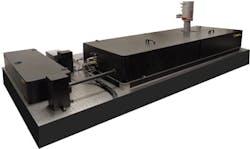KMLabs' Wyvern-HE delivers multi-stage ultrafast laser amplifier performance in a smaller, lower-cost, single-stage package
The 2013 CLEO/Laser Focus World Innovation Awards program honors the most timely, groundbreaking products in the field of photonics and laser science. The awards are sponsored by Laser Focus World and the Conference on Lasers and Electro Optics (CLEO).
Each year, Innovation Award entrants are challenged to show how their application, service, or product (launched in the 18 months between September 27, 2011, and March 27, 2013) met several key criteria, including significant impact to the photonics industry, unique functionality and long life expectancy, secure patent position, and above all, an exceptional level of innovation.
For 2013, one winner and three honorable mentions were chosen. The awards are presented each year at the CLEO Plenary Session, which for CLEO: 2013 is Tuesday, June 11, in San Jose, CA. Information on the Innovation Awards can be found online at http://bit.ly/Iak9ZO.
INNOVATION AWARD WINNER
Kapteyn-Murnane Laboratories (KMLabs; Boulder, CO)
The 2013 CLEO/Laser Focus World Innovation Award winner was KMLabs (www.kmlabs.com) for the development of the Wyvern-HE—a high-energy, single-stage, single-pump Ti:sapphire ultrafast amplifier delivering performance (9 mJ at 1 kHz with computer-controlled repetition rate) that has historically only been possible with much larger and more expensive multi-stage designs. Motivation for the product was provided by JILA researchers who needed high-energy pulses with excellent beam quality to pump an optical parametric amplifier (OPA). Multi-millijoule OPA pulses in the 1.3 to 2 μm range could then be used to generate ultrafast, coherent, high harmonic x-rays for a host of applications in nano and molecular science. Additional applications include fundamental materials/surface science, attosecond science, pump-probe studies in chemistry/physics, and imaging/spectroscopy applications.
The Wyvern-HE design uses proprietary cryogenic cooling and regenerative amplification beyond today's commercial norms to achieve a pulse energy specification of more than 9 mJ (compared to competitive designs with just 5 mJ) with less than 45 fs pulse duration at a 1 kHz repetition rate, again using a single, compact regenerative amplification stage in a package that is 50% smaller and 40% less expensive than current multi-stage ultrafast amplifier systems performing at the same level. The peak power of the pulses can reach as high as 0.2 TW, a new record peak power for a single-stage amplifier.
HONORABLE MENTIONS
Femtolasers Produktions GmbH (Vienna, Austria)
The first of three 2013 Innovation Awards honorable mentions (in no particular order) went to Femtolasers Produktions (www.femtolasers.com) for its portable ultrafast Ti:sapphire laser for biomedical applications. Femtolasers' INTEGRAL core is the smallest commercially available sub-8 fs ultrafast Ti:sapphire laser, providing up to 200 mW average power with 300 MHz pulse repetition rate for terahertz, multiphoton microscopy, optical coherence tomography (OCT), and spectroscopy applications.
With active power stabilization, internal safety diagnostics, and a laser head that weighs about 6 kg, INTEGRAL core is the very first handheld Ti:sapphire laser that can provide sufficient pulse peak power for almost every nonlinear imaging application and sufficient wavelength coverage for sub-2 μm axial resolutions in ultrahigh-speed OCT applications.
Princeton Instruments (Trenton, NJ)
The second honorable mention was awarded to Princeton Instruments (www.princetoninstruments.com) for IsoPlane, a next-generation, aberration-free spectrograph. The IsoPlane SCT 320 Schmidt-Czerny-Turner spectrograph overcomes the limitations of traditional Czerny-Turner designs by totally eliminating field astigmatism and greatly reducing coma and spherical aberration.
IsoPlane is the first research-grade imaging spectrograph to achieve an image quality approaching the Nyquist limit of its CCD detectors. The overall optical performance of the IsoPlane is best described by its modulation transfer function: 16 line pairs/mm at 50% contrast for improved performance in multi-channel spectroscopy, fluorescence, and biomedical imaging applications.
TAG Optics (Princeton, NJ)
Finally, the third honorable mention in the 2013 CLEO/LFW Innovation Awards went to TAG Optics (www.tag-optics.com) for the ultrahigh-speed TAG Lens 2.0, a varifocal lens that can extend the depth-of-field of conventional optical systems and enable user-selected focal lengths by using sound to shape light.
Unlike other liquid lenses that rely on the deformation of a surface or interface, the TAG Lens 2.0 uses a piezoelectric element to generate sound in the liquid, resulting in a dynamic refractive-index profile matching a large aperture aspherical lens element controlled by the user. The acoustic effect enables scanning over a continuous range of focal lengths in microseconds-orders of magnitude faster than competitive devices.



